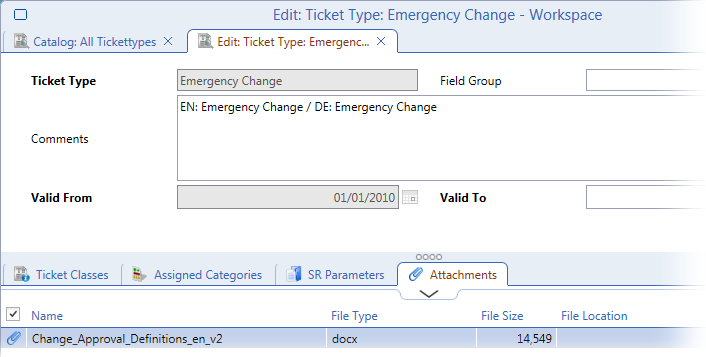Change Authorization
Authorization Rules
Requested change authorization and its hierarchy can be documented at the Ticket Type level using one or more attachments linked to the Change Type via its 'Attachments' reference catalog.
The approval person(s) or group(s) of a specific change depend on several criteria, such as:
- Change type and category: only Change Manager or CAB or ECAB
- Related CIs of the change: System Owner or Service Owner
- Related Release of that change: Release Manager
All detailed approvals are documented in corresponding process task instances, change activities and log descriptions.

Authorization Process
Throughout its life cycle, the Change proceeds through different statuses. Status transitions are tracked and stored in change log descriptions. When an approval/authorization is done, the status changes and this event gets documented in a new 'Description', including additional date/time and person/user information.
The permissions to individual steps in change processing are based on Valuemation authorization roles. In standard customization, the permission to authorize changes is granted to the 'Change Management' role.
Change Authorization Roles
-Chm.Change Basic Read |
Rights to read all ticket information in this area (incl. print) |
-Chm.Change Initiation |
Rights to initiate new RFC/Change tickets. The role 'Change Initiatior (CI)' has the following tasks: |
-Chm.Change Support |
Rights to do the operational work in this area. The role 'Change Support (CS)' has the following tasks: |
-Chm.Change Management |
Rights to do the management work in this area, such as approvals, reports, prints. The role 'Change Management (CM)' has the following tasks: |
If organizational entities such as CAB are involved in change authorization, special process tasks for the corresponding organizational group are created.
Change Organizational Roles
CAB (Change Advisory Board)
- Definition: A group of people that advises the Change Manager in the assessment, prioritization and scheduling of Changes. This board is usually made up of representatives from all areas within the IT Service Provider, the Business, and Third Parties such as Suppliers.
- Valuemation Context: CAB is an organizational role and not a permission role, which means that a support group is used for this role. Activities and process tasks can be assigned to this support group.
The Change Manager is the chairman of a CAB meeting and has the final responsibility for the Change process flow after consulting with CAB members.
ECAB (Emergency Change Advisory Board)
- Definition: A subset of the Change Advisory Board that makes decisions about high impact Emergency Changes. Actual membership of the ECAB may be decided at the time a meeting is called, and depends on the nature of the Emergency Change.
- Valuemation Context: ECAB is an organizational role (based on ITIL specifications) and not a permission role, which means that a supportgroup is used for this role. Activities and workorders can be assigned to this supportgroup, they are then processed in Valuemation by the Change Manager as a member of ECAB.